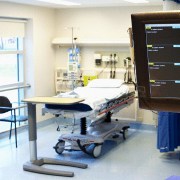 Photo: Getty Images
Photo: Getty Images
Nobody much wants to go there. Not as a visitor, nor as a patient swathed in tubes in one of the beds of the ICU.
But when health and well-being are tipping precariously in the balance, and constant monitoring and care is required, this is the place to be.
ICU is another name for the Intensive Care Unit. It may also be called a Critical Care Unit (CCU). It's set up for life-threatening scenarios involving accidents, breathing problems, infections, organ failure or surgery.
Its decor is Early Medical -- make that Futuristic Medical -- with catheters, IV tubes, monitors and ventilators as the accent pieces. Patients are brought to the ICU for constant monitoring and care.
The staff of the ICU is specially trained. They stay focused on keeping the major body systems online. As the cardiovascular system, the central nervous system, the gastrointestinal tract and the respiratory tract continue to function, the patient's chances of recovery improve.
While in the ICU, you may have an IV, which is an intravenous catheter providing you with fluids and medications.
Monitors are like extra sets of eyes for the doctors and nurses. You may have a monitor for your heart rate or breathing rate. You may be hooked up to a pulse oximetry machine to watch your blood oxygen levels. Maybe you'll have a blood pressure cuff around your arm.
When it's time to leave the ICU, you may be able to go home or you may be moved to a different part of the hospital to continue your recovery.
Children have their own section called the Pediatric Intensive Care Unit, or the PICU. Sometimes a child will have been moved from another part of the hospital if they've gotten sicker during their hospital stay or if they've had surgery. Other times a child will go immediately to PICU if they came into the hospital with a life-threatening condition.
There are more nurses per patient in the PICU than any other part of the hospital. This means each nurse has more one-on-one time for each child, allowing them to provide constant care and reassurance to a sick and possibly frightened child.
The PICU team also has residents (doctors training to become pediatricians) and PICU fellows. These are pediatricians who are training for intensive care.
The PICU team may also include cardiologists and neurosurgeons, nutritionists and pharmacists. There may be occupational therapists, physical therapists and respiratory therapists.
Social workers may be available to help families dealing with the challenges of having a child who is seriously ill. These social workers can help find housing, and help make arrangements when it's time to leave the hospital and go back home.
Resources:
Critical Care (Also called: Intensive care)
http://www.nlm.nih.gov/medlineplus/criticalcare.html
What is an ICU?
http://www.wisegeek.com/what-is-an-icu.htm
When Your Child's in the Pediatric Intensive Care Unit
http://kidshealth.org/parent/system/ill/picu.html
Visit Jody's website and blog at http://www.ncubator.ca and http://ncubator.ca/blogger





Add a CommentComments
There are no comments yet. Be the first one and get the conversation started!